Criminal Statute Interpretation: Grajewski and Vaziri Cases Analysis
VerifiedAdded on 2022/07/28
|11
|4162
|53
Report
AI Summary
This report delves into the complexities of statutory interpretation within the realm of criminal law, focusing on two significant High Court cases: Grajewski v Director of Public Prosecutions (NSW) and R v A2, Magennis and Vaziri. The Grajewski case examines the interpretation of the word 'damage' in a criminal statute, where the court adopted a narrow, literal approach. The report analyzes the application of the literal and purposive approaches, examining how the court considered the ordinary meaning of the word and the intent of the legislation. In contrast, the Vaziri case involves the interpretation of the term 'mutilates,' where the court employed the mischief rule to ascertain the legislative intent to eradicate female genital mutilation. The report contrasts these differing approaches, highlighting the factors influencing the court's decision to apply a narrow or wider interpretation based on the context and the specific criminal provision. The report also explores the rule of lenity and its impact on interpreting criminal statutes and compares the outcomes of the two cases, emphasizing the importance of understanding the different approaches to statutory interpretation to ensure certainty and fairness in the application of criminal law.
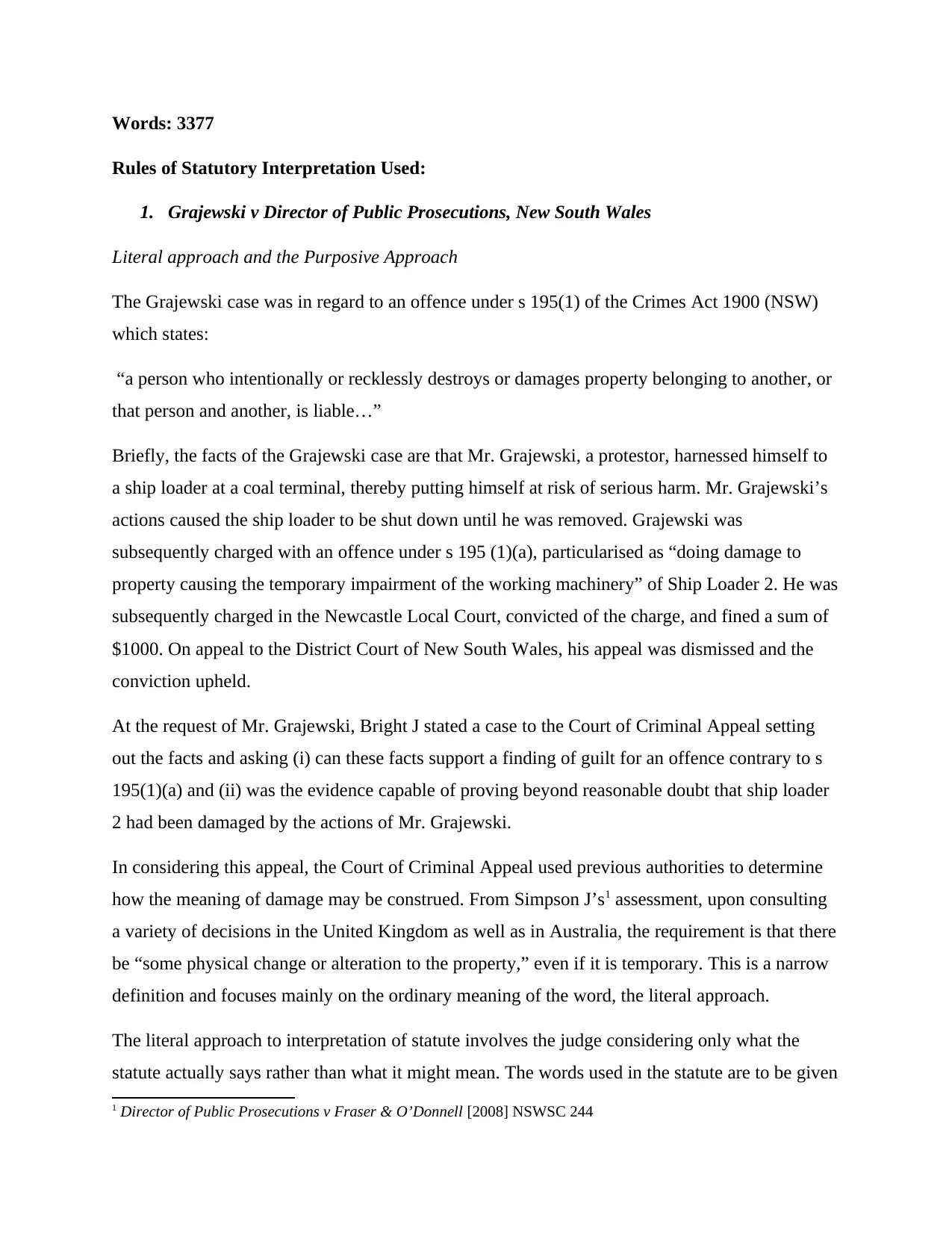
Words: 3377
Rules of Statutory Interpretation Used:
1. Grajewski v Director of Public Prosecutions, New South Wales
Literal approach and the Purposive Approach
The Grajewski case was in regard to an offence under s 195(1) of the Crimes Act 1900 (NSW)
which states:
“a person who intentionally or recklessly destroys or damages property belonging to another, or
that person and another, is liable…”
Briefly, the facts of the Grajewski case are that Mr. Grajewski, a protestor, harnessed himself to
a ship loader at a coal terminal, thereby putting himself at risk of serious harm. Mr. Grajewski’s
actions caused the ship loader to be shut down until he was removed. Grajewski was
subsequently charged with an offence under s 195 (1)(a), particularised as “doing damage to
property causing the temporary impairment of the working machinery” of Ship Loader 2. He was
subsequently charged in the Newcastle Local Court, convicted of the charge, and fined a sum of
$1000. On appeal to the District Court of New South Wales, his appeal was dismissed and the
conviction upheld.
At the request of Mr. Grajewski, Bright J stated a case to the Court of Criminal Appeal setting
out the facts and asking (i) can these facts support a finding of guilt for an offence contrary to s
195(1)(a) and (ii) was the evidence capable of proving beyond reasonable doubt that ship loader
2 had been damaged by the actions of Mr. Grajewski.
In considering this appeal, the Court of Criminal Appeal used previous authorities to determine
how the meaning of damage may be construed. From Simpson J’s1 assessment, upon consulting
a variety of decisions in the United Kingdom as well as in Australia, the requirement is that there
be “some physical change or alteration to the property,” even if it is temporary. This is a narrow
definition and focuses mainly on the ordinary meaning of the word, the literal approach.
The literal approach to interpretation of statute involves the judge considering only what the
statute actually says rather than what it might mean. The words used in the statute are to be given
1 Director of Public Prosecutions v Fraser & O’Donnell [2008] NSWSC 244
Rules of Statutory Interpretation Used:
1. Grajewski v Director of Public Prosecutions, New South Wales
Literal approach and the Purposive Approach
The Grajewski case was in regard to an offence under s 195(1) of the Crimes Act 1900 (NSW)
which states:
“a person who intentionally or recklessly destroys or damages property belonging to another, or
that person and another, is liable…”
Briefly, the facts of the Grajewski case are that Mr. Grajewski, a protestor, harnessed himself to
a ship loader at a coal terminal, thereby putting himself at risk of serious harm. Mr. Grajewski’s
actions caused the ship loader to be shut down until he was removed. Grajewski was
subsequently charged with an offence under s 195 (1)(a), particularised as “doing damage to
property causing the temporary impairment of the working machinery” of Ship Loader 2. He was
subsequently charged in the Newcastle Local Court, convicted of the charge, and fined a sum of
$1000. On appeal to the District Court of New South Wales, his appeal was dismissed and the
conviction upheld.
At the request of Mr. Grajewski, Bright J stated a case to the Court of Criminal Appeal setting
out the facts and asking (i) can these facts support a finding of guilt for an offence contrary to s
195(1)(a) and (ii) was the evidence capable of proving beyond reasonable doubt that ship loader
2 had been damaged by the actions of Mr. Grajewski.
In considering this appeal, the Court of Criminal Appeal used previous authorities to determine
how the meaning of damage may be construed. From Simpson J’s1 assessment, upon consulting
a variety of decisions in the United Kingdom as well as in Australia, the requirement is that there
be “some physical change or alteration to the property,” even if it is temporary. This is a narrow
definition and focuses mainly on the ordinary meaning of the word, the literal approach.
The literal approach to interpretation of statute involves the judge considering only what the
statute actually says rather than what it might mean. The words used in the statute are to be given
1 Director of Public Prosecutions v Fraser & O’Donnell [2008] NSWSC 244
Paraphrase This Document
Need a fresh take? Get an instant paraphrase of this document with our AI Paraphraser
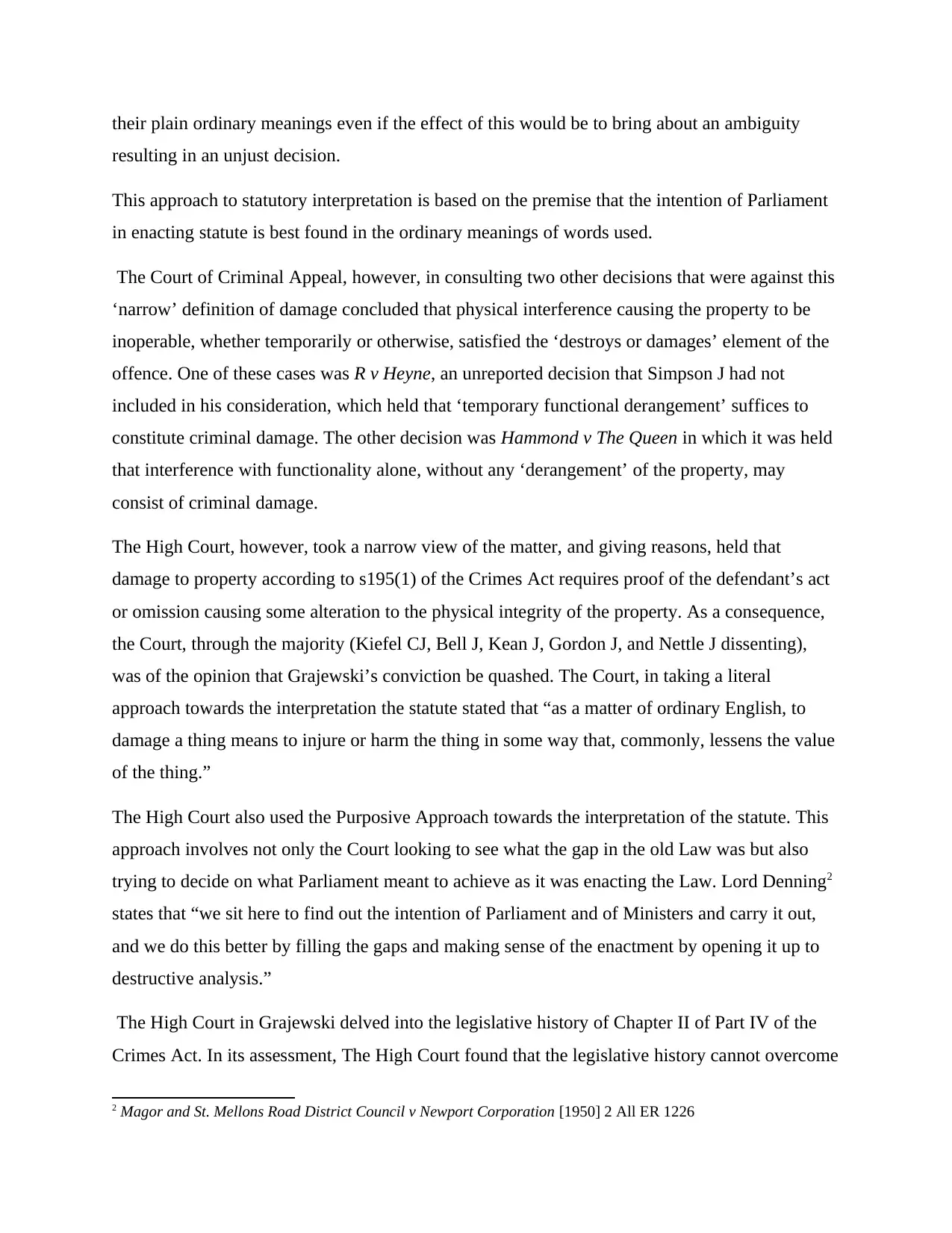
their plain ordinary meanings even if the effect of this would be to bring about an ambiguity
resulting in an unjust decision.
This approach to statutory interpretation is based on the premise that the intention of Parliament
in enacting statute is best found in the ordinary meanings of words used.
The Court of Criminal Appeal, however, in consulting two other decisions that were against this
‘narrow’ definition of damage concluded that physical interference causing the property to be
inoperable, whether temporarily or otherwise, satisfied the ‘destroys or damages’ element of the
offence. One of these cases was R v Heyne, an unreported decision that Simpson J had not
included in his consideration, which held that ‘temporary functional derangement’ suffices to
constitute criminal damage. The other decision was Hammond v The Queen in which it was held
that interference with functionality alone, without any ‘derangement’ of the property, may
consist of criminal damage.
The High Court, however, took a narrow view of the matter, and giving reasons, held that
damage to property according to s195(1) of the Crimes Act requires proof of the defendant’s act
or omission causing some alteration to the physical integrity of the property. As a consequence,
the Court, through the majority (Kiefel CJ, Bell J, Kean J, Gordon J, and Nettle J dissenting),
was of the opinion that Grajewski’s conviction be quashed. The Court, in taking a literal
approach towards the interpretation the statute stated that “as a matter of ordinary English, to
damage a thing means to injure or harm the thing in some way that, commonly, lessens the value
of the thing.”
The High Court also used the Purposive Approach towards the interpretation of the statute. This
approach involves not only the Court looking to see what the gap in the old Law was but also
trying to decide on what Parliament meant to achieve as it was enacting the Law. Lord Denning2
states that “we sit here to find out the intention of Parliament and of Ministers and carry it out,
and we do this better by filling the gaps and making sense of the enactment by opening it up to
destructive analysis.”
The High Court in Grajewski delved into the legislative history of Chapter II of Part IV of the
Crimes Act. In its assessment, The High Court found that the legislative history cannot overcome
2 Magor and St. Mellons Road District Council v Newport Corporation [1950] 2 All ER 1226
resulting in an unjust decision.
This approach to statutory interpretation is based on the premise that the intention of Parliament
in enacting statute is best found in the ordinary meanings of words used.
The Court of Criminal Appeal, however, in consulting two other decisions that were against this
‘narrow’ definition of damage concluded that physical interference causing the property to be
inoperable, whether temporarily or otherwise, satisfied the ‘destroys or damages’ element of the
offence. One of these cases was R v Heyne, an unreported decision that Simpson J had not
included in his consideration, which held that ‘temporary functional derangement’ suffices to
constitute criminal damage. The other decision was Hammond v The Queen in which it was held
that interference with functionality alone, without any ‘derangement’ of the property, may
consist of criminal damage.
The High Court, however, took a narrow view of the matter, and giving reasons, held that
damage to property according to s195(1) of the Crimes Act requires proof of the defendant’s act
or omission causing some alteration to the physical integrity of the property. As a consequence,
the Court, through the majority (Kiefel CJ, Bell J, Kean J, Gordon J, and Nettle J dissenting),
was of the opinion that Grajewski’s conviction be quashed. The Court, in taking a literal
approach towards the interpretation the statute stated that “as a matter of ordinary English, to
damage a thing means to injure or harm the thing in some way that, commonly, lessens the value
of the thing.”
The High Court also used the Purposive Approach towards the interpretation of the statute. This
approach involves not only the Court looking to see what the gap in the old Law was but also
trying to decide on what Parliament meant to achieve as it was enacting the Law. Lord Denning2
states that “we sit here to find out the intention of Parliament and of Ministers and carry it out,
and we do this better by filling the gaps and making sense of the enactment by opening it up to
destructive analysis.”
The High Court in Grajewski delved into the legislative history of Chapter II of Part IV of the
Crimes Act. In its assessment, The High Court found that the legislative history cannot overcome
2 Magor and St. Mellons Road District Council v Newport Corporation [1950] 2 All ER 1226
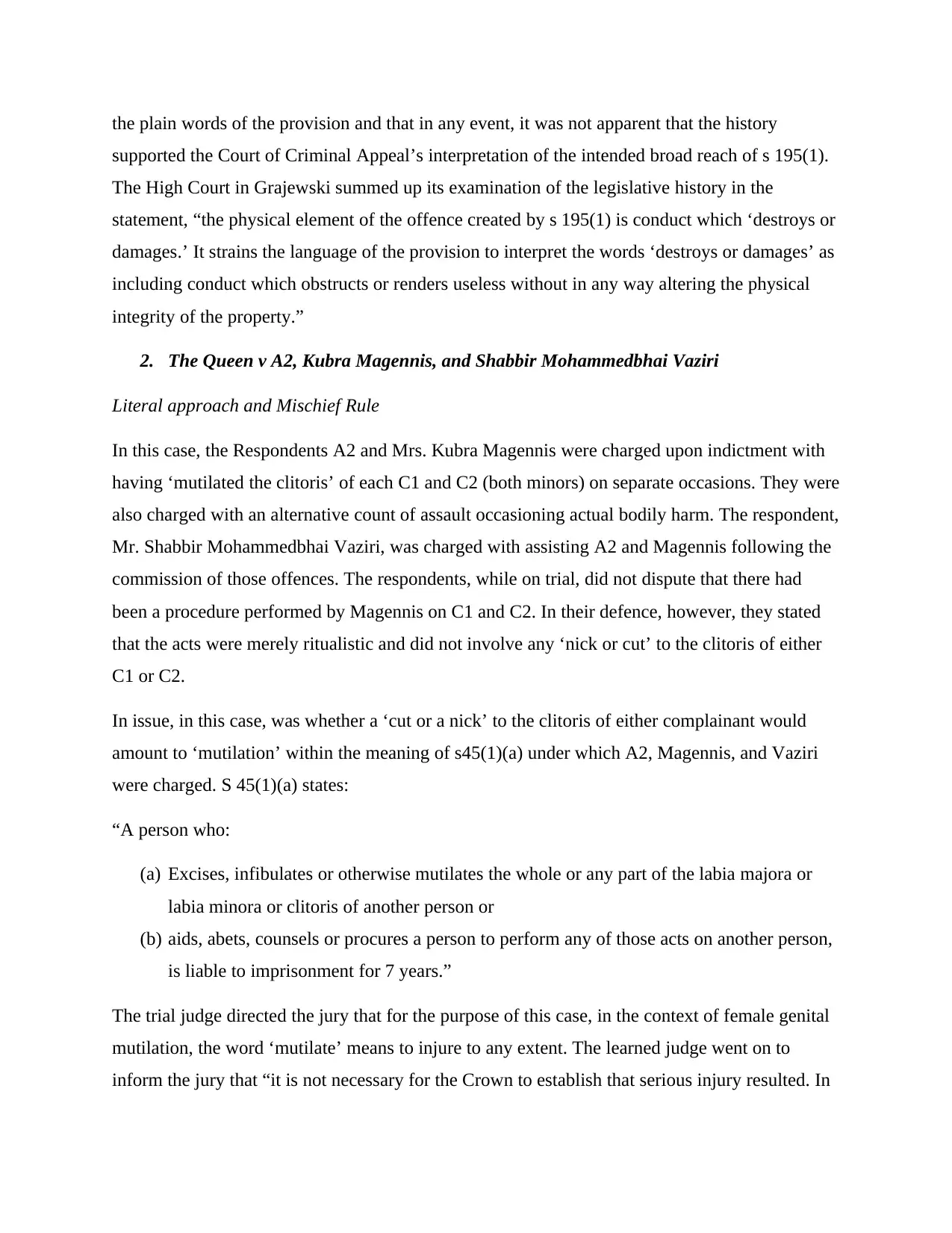
the plain words of the provision and that in any event, it was not apparent that the history
supported the Court of Criminal Appeal’s interpretation of the intended broad reach of s 195(1).
The High Court in Grajewski summed up its examination of the legislative history in the
statement, “the physical element of the offence created by s 195(1) is conduct which ‘destroys or
damages.’ It strains the language of the provision to interpret the words ‘destroys or damages’ as
including conduct which obstructs or renders useless without in any way altering the physical
integrity of the property.”
2. The Queen v A2, Kubra Magennis, and Shabbir Mohammedbhai Vaziri
Literal approach and Mischief Rule
In this case, the Respondents A2 and Mrs. Kubra Magennis were charged upon indictment with
having ‘mutilated the clitoris’ of each C1 and C2 (both minors) on separate occasions. They were
also charged with an alternative count of assault occasioning actual bodily harm. The respondent,
Mr. Shabbir Mohammedbhai Vaziri, was charged with assisting A2 and Magennis following the
commission of those offences. The respondents, while on trial, did not dispute that there had
been a procedure performed by Magennis on C1 and C2. In their defence, however, they stated
that the acts were merely ritualistic and did not involve any ‘nick or cut’ to the clitoris of either
C1 or C2.
In issue, in this case, was whether a ‘cut or a nick’ to the clitoris of either complainant would
amount to ‘mutilation’ within the meaning of s45(1)(a) under which A2, Magennis, and Vaziri
were charged. S 45(1)(a) states:
“A person who:
(a) Excises, infibulates or otherwise mutilates the whole or any part of the labia majora or
labia minora or clitoris of another person or
(b) aids, abets, counsels or procures a person to perform any of those acts on another person,
is liable to imprisonment for 7 years.”
The trial judge directed the jury that for the purpose of this case, in the context of female genital
mutilation, the word ‘mutilate’ means to injure to any extent. The learned judge went on to
inform the jury that “it is not necessary for the Crown to establish that serious injury resulted. In
supported the Court of Criminal Appeal’s interpretation of the intended broad reach of s 195(1).
The High Court in Grajewski summed up its examination of the legislative history in the
statement, “the physical element of the offence created by s 195(1) is conduct which ‘destroys or
damages.’ It strains the language of the provision to interpret the words ‘destroys or damages’ as
including conduct which obstructs or renders useless without in any way altering the physical
integrity of the property.”
2. The Queen v A2, Kubra Magennis, and Shabbir Mohammedbhai Vaziri
Literal approach and Mischief Rule
In this case, the Respondents A2 and Mrs. Kubra Magennis were charged upon indictment with
having ‘mutilated the clitoris’ of each C1 and C2 (both minors) on separate occasions. They were
also charged with an alternative count of assault occasioning actual bodily harm. The respondent,
Mr. Shabbir Mohammedbhai Vaziri, was charged with assisting A2 and Magennis following the
commission of those offences. The respondents, while on trial, did not dispute that there had
been a procedure performed by Magennis on C1 and C2. In their defence, however, they stated
that the acts were merely ritualistic and did not involve any ‘nick or cut’ to the clitoris of either
C1 or C2.
In issue, in this case, was whether a ‘cut or a nick’ to the clitoris of either complainant would
amount to ‘mutilation’ within the meaning of s45(1)(a) under which A2, Magennis, and Vaziri
were charged. S 45(1)(a) states:
“A person who:
(a) Excises, infibulates or otherwise mutilates the whole or any part of the labia majora or
labia minora or clitoris of another person or
(b) aids, abets, counsels or procures a person to perform any of those acts on another person,
is liable to imprisonment for 7 years.”
The trial judge directed the jury that for the purpose of this case, in the context of female genital
mutilation, the word ‘mutilate’ means to injure to any extent. The learned judge went on to
inform the jury that “it is not necessary for the Crown to establish that serious injury resulted. In
⊘ This is a preview!⊘
Do you want full access?
Subscribe today to unlock all pages.

Trusted by 1+ million students worldwide
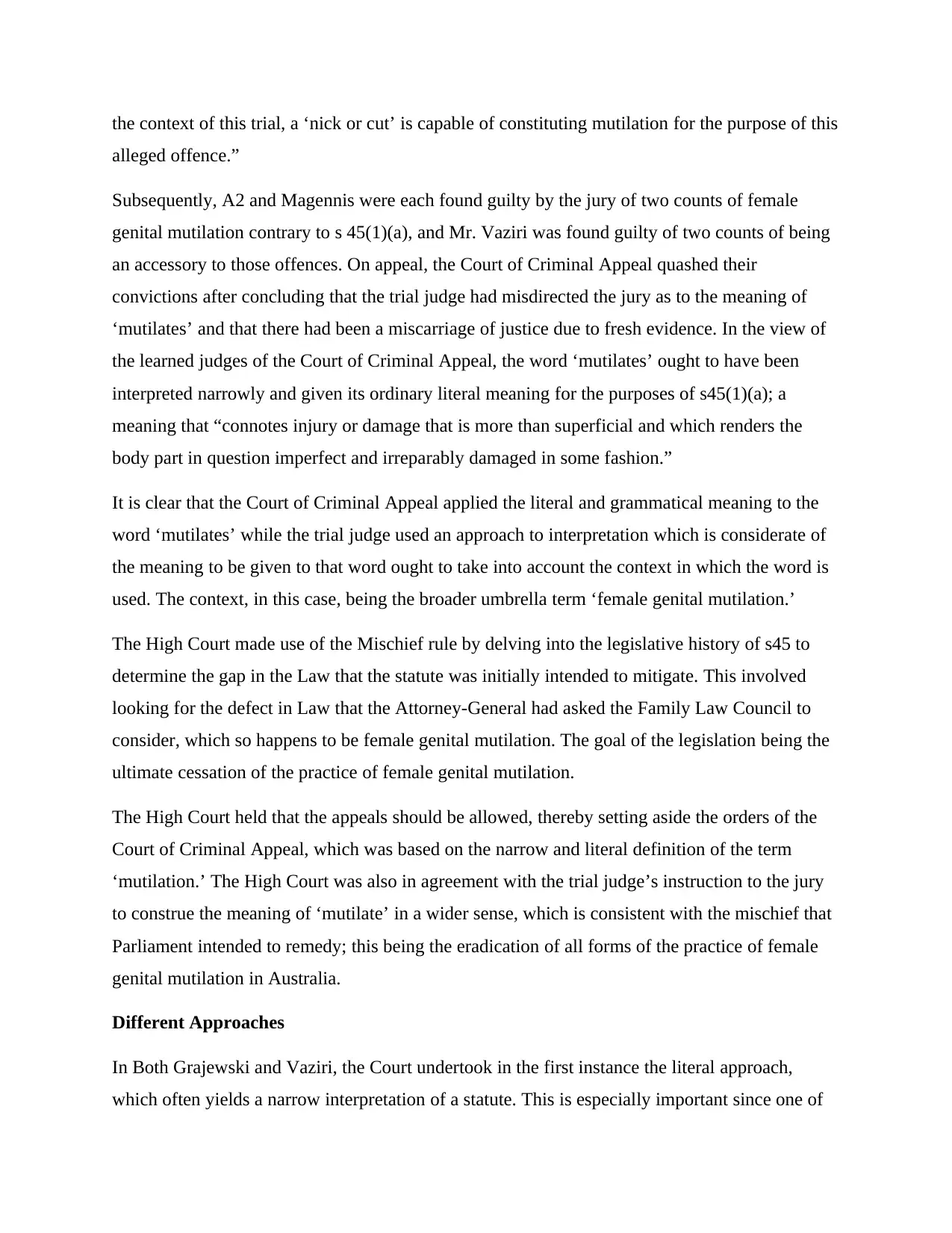
the context of this trial, a ‘nick or cut’ is capable of constituting mutilation for the purpose of this
alleged offence.”
Subsequently, A2 and Magennis were each found guilty by the jury of two counts of female
genital mutilation contrary to s 45(1)(a), and Mr. Vaziri was found guilty of two counts of being
an accessory to those offences. On appeal, the Court of Criminal Appeal quashed their
convictions after concluding that the trial judge had misdirected the jury as to the meaning of
‘mutilates’ and that there had been a miscarriage of justice due to fresh evidence. In the view of
the learned judges of the Court of Criminal Appeal, the word ‘mutilates’ ought to have been
interpreted narrowly and given its ordinary literal meaning for the purposes of s45(1)(a); a
meaning that “connotes injury or damage that is more than superficial and which renders the
body part in question imperfect and irreparably damaged in some fashion.”
It is clear that the Court of Criminal Appeal applied the literal and grammatical meaning to the
word ‘mutilates’ while the trial judge used an approach to interpretation which is considerate of
the meaning to be given to that word ought to take into account the context in which the word is
used. The context, in this case, being the broader umbrella term ‘female genital mutilation.’
The High Court made use of the Mischief rule by delving into the legislative history of s45 to
determine the gap in the Law that the statute was initially intended to mitigate. This involved
looking for the defect in Law that the Attorney-General had asked the Family Law Council to
consider, which so happens to be female genital mutilation. The goal of the legislation being the
ultimate cessation of the practice of female genital mutilation.
The High Court held that the appeals should be allowed, thereby setting aside the orders of the
Court of Criminal Appeal, which was based on the narrow and literal definition of the term
‘mutilation.’ The High Court was also in agreement with the trial judge’s instruction to the jury
to construe the meaning of ‘mutilate’ in a wider sense, which is consistent with the mischief that
Parliament intended to remedy; this being the eradication of all forms of the practice of female
genital mutilation in Australia.
Different Approaches
In Both Grajewski and Vaziri, the Court undertook in the first instance the literal approach,
which often yields a narrow interpretation of a statute. This is especially important since one of
alleged offence.”
Subsequently, A2 and Magennis were each found guilty by the jury of two counts of female
genital mutilation contrary to s 45(1)(a), and Mr. Vaziri was found guilty of two counts of being
an accessory to those offences. On appeal, the Court of Criminal Appeal quashed their
convictions after concluding that the trial judge had misdirected the jury as to the meaning of
‘mutilates’ and that there had been a miscarriage of justice due to fresh evidence. In the view of
the learned judges of the Court of Criminal Appeal, the word ‘mutilates’ ought to have been
interpreted narrowly and given its ordinary literal meaning for the purposes of s45(1)(a); a
meaning that “connotes injury or damage that is more than superficial and which renders the
body part in question imperfect and irreparably damaged in some fashion.”
It is clear that the Court of Criminal Appeal applied the literal and grammatical meaning to the
word ‘mutilates’ while the trial judge used an approach to interpretation which is considerate of
the meaning to be given to that word ought to take into account the context in which the word is
used. The context, in this case, being the broader umbrella term ‘female genital mutilation.’
The High Court made use of the Mischief rule by delving into the legislative history of s45 to
determine the gap in the Law that the statute was initially intended to mitigate. This involved
looking for the defect in Law that the Attorney-General had asked the Family Law Council to
consider, which so happens to be female genital mutilation. The goal of the legislation being the
ultimate cessation of the practice of female genital mutilation.
The High Court held that the appeals should be allowed, thereby setting aside the orders of the
Court of Criminal Appeal, which was based on the narrow and literal definition of the term
‘mutilation.’ The High Court was also in agreement with the trial judge’s instruction to the jury
to construe the meaning of ‘mutilate’ in a wider sense, which is consistent with the mischief that
Parliament intended to remedy; this being the eradication of all forms of the practice of female
genital mutilation in Australia.
Different Approaches
In Both Grajewski and Vaziri, the Court undertook in the first instance the literal approach,
which often yields a narrow interpretation of a statute. This is especially important since one of
Paraphrase This Document
Need a fresh take? Get an instant paraphrase of this document with our AI Paraphraser
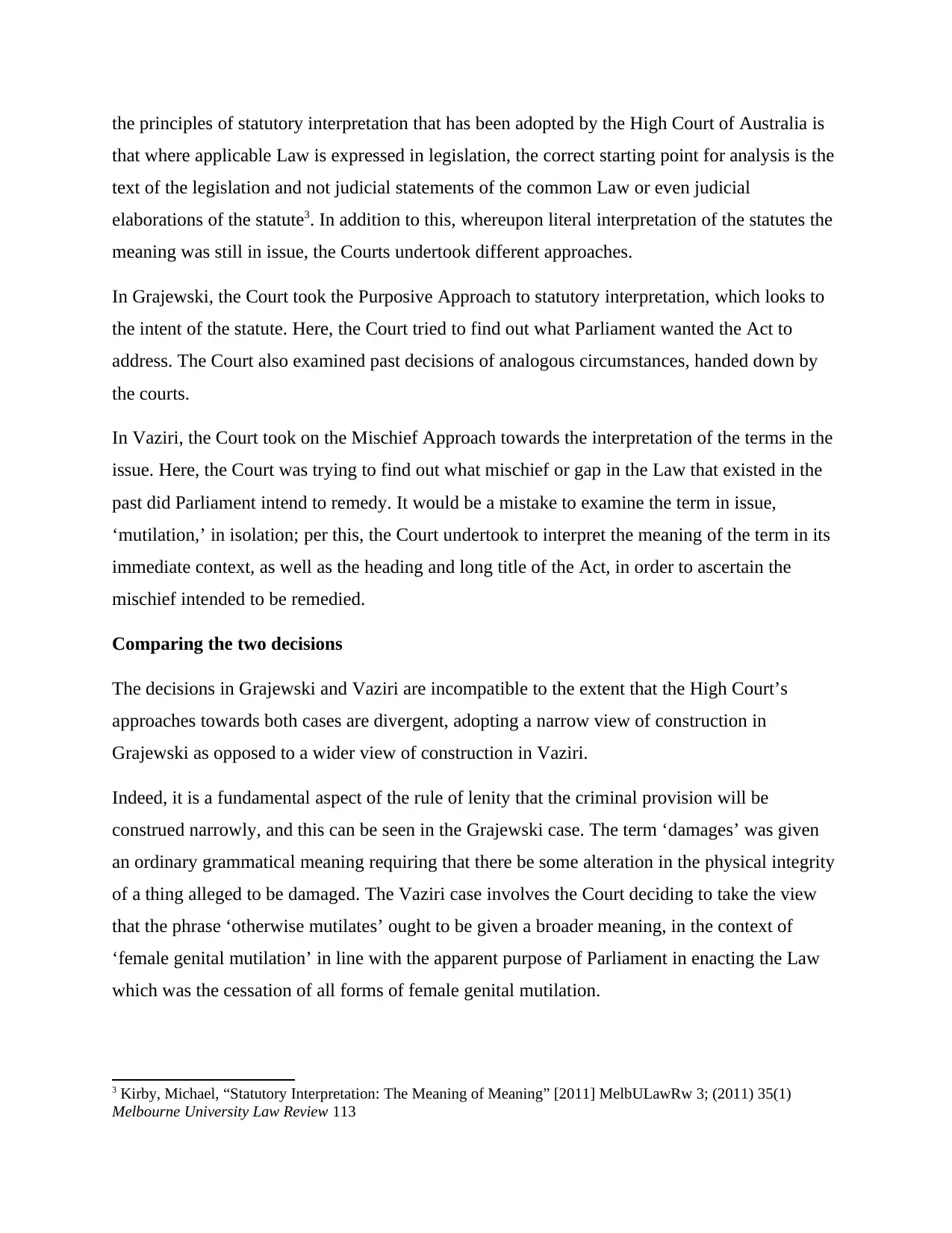
the principles of statutory interpretation that has been adopted by the High Court of Australia is
that where applicable Law is expressed in legislation, the correct starting point for analysis is the
text of the legislation and not judicial statements of the common Law or even judicial
elaborations of the statute3. In addition to this, whereupon literal interpretation of the statutes the
meaning was still in issue, the Courts undertook different approaches.
In Grajewski, the Court took the Purposive Approach to statutory interpretation, which looks to
the intent of the statute. Here, the Court tried to find out what Parliament wanted the Act to
address. The Court also examined past decisions of analogous circumstances, handed down by
the courts.
In Vaziri, the Court took on the Mischief Approach towards the interpretation of the terms in the
issue. Here, the Court was trying to find out what mischief or gap in the Law that existed in the
past did Parliament intend to remedy. It would be a mistake to examine the term in issue,
‘mutilation,’ in isolation; per this, the Court undertook to interpret the meaning of the term in its
immediate context, as well as the heading and long title of the Act, in order to ascertain the
mischief intended to be remedied.
Comparing the two decisions
The decisions in Grajewski and Vaziri are incompatible to the extent that the High Court’s
approaches towards both cases are divergent, adopting a narrow view of construction in
Grajewski as opposed to a wider view of construction in Vaziri.
Indeed, it is a fundamental aspect of the rule of lenity that the criminal provision will be
construed narrowly, and this can be seen in the Grajewski case. The term ‘damages’ was given
an ordinary grammatical meaning requiring that there be some alteration in the physical integrity
of a thing alleged to be damaged. The Vaziri case involves the Court deciding to take the view
that the phrase ‘otherwise mutilates’ ought to be given a broader meaning, in the context of
‘female genital mutilation’ in line with the apparent purpose of Parliament in enacting the Law
which was the cessation of all forms of female genital mutilation.
3 Kirby, Michael, “Statutory Interpretation: The Meaning of Meaning” [2011] MelbULawRw 3; (2011) 35(1)
Melbourne University Law Review 113
that where applicable Law is expressed in legislation, the correct starting point for analysis is the
text of the legislation and not judicial statements of the common Law or even judicial
elaborations of the statute3. In addition to this, whereupon literal interpretation of the statutes the
meaning was still in issue, the Courts undertook different approaches.
In Grajewski, the Court took the Purposive Approach to statutory interpretation, which looks to
the intent of the statute. Here, the Court tried to find out what Parliament wanted the Act to
address. The Court also examined past decisions of analogous circumstances, handed down by
the courts.
In Vaziri, the Court took on the Mischief Approach towards the interpretation of the terms in the
issue. Here, the Court was trying to find out what mischief or gap in the Law that existed in the
past did Parliament intend to remedy. It would be a mistake to examine the term in issue,
‘mutilation,’ in isolation; per this, the Court undertook to interpret the meaning of the term in its
immediate context, as well as the heading and long title of the Act, in order to ascertain the
mischief intended to be remedied.
Comparing the two decisions
The decisions in Grajewski and Vaziri are incompatible to the extent that the High Court’s
approaches towards both cases are divergent, adopting a narrow view of construction in
Grajewski as opposed to a wider view of construction in Vaziri.
Indeed, it is a fundamental aspect of the rule of lenity that the criminal provision will be
construed narrowly, and this can be seen in the Grajewski case. The term ‘damages’ was given
an ordinary grammatical meaning requiring that there be some alteration in the physical integrity
of a thing alleged to be damaged. The Vaziri case involves the Court deciding to take the view
that the phrase ‘otherwise mutilates’ ought to be given a broader meaning, in the context of
‘female genital mutilation’ in line with the apparent purpose of Parliament in enacting the Law
which was the cessation of all forms of female genital mutilation.
3 Kirby, Michael, “Statutory Interpretation: The Meaning of Meaning” [2011] MelbULawRw 3; (2011) 35(1)
Melbourne University Law Review 113
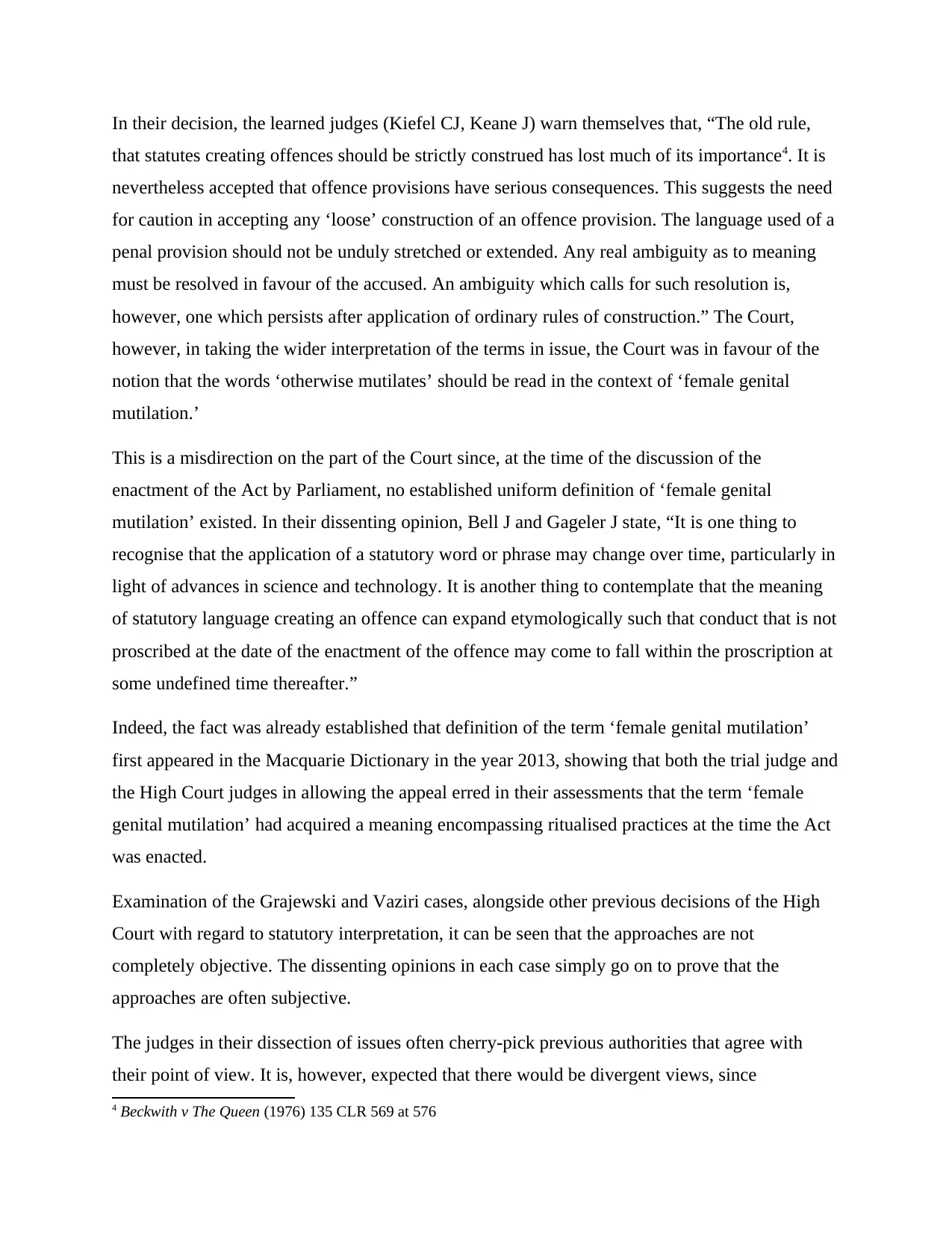
In their decision, the learned judges (Kiefel CJ, Keane J) warn themselves that, “The old rule,
that statutes creating offences should be strictly construed has lost much of its importance4. It is
nevertheless accepted that offence provisions have serious consequences. This suggests the need
for caution in accepting any ‘loose’ construction of an offence provision. The language used of a
penal provision should not be unduly stretched or extended. Any real ambiguity as to meaning
must be resolved in favour of the accused. An ambiguity which calls for such resolution is,
however, one which persists after application of ordinary rules of construction.” The Court,
however, in taking the wider interpretation of the terms in issue, the Court was in favour of the
notion that the words ‘otherwise mutilates’ should be read in the context of ‘female genital
mutilation.’
This is a misdirection on the part of the Court since, at the time of the discussion of the
enactment of the Act by Parliament, no established uniform definition of ‘female genital
mutilation’ existed. In their dissenting opinion, Bell J and Gageler J state, “It is one thing to
recognise that the application of a statutory word or phrase may change over time, particularly in
light of advances in science and technology. It is another thing to contemplate that the meaning
of statutory language creating an offence can expand etymologically such that conduct that is not
proscribed at the date of the enactment of the offence may come to fall within the proscription at
some undefined time thereafter.”
Indeed, the fact was already established that definition of the term ‘female genital mutilation’
first appeared in the Macquarie Dictionary in the year 2013, showing that both the trial judge and
the High Court judges in allowing the appeal erred in their assessments that the term ‘female
genital mutilation’ had acquired a meaning encompassing ritualised practices at the time the Act
was enacted.
Examination of the Grajewski and Vaziri cases, alongside other previous decisions of the High
Court with regard to statutory interpretation, it can be seen that the approaches are not
completely objective. The dissenting opinions in each case simply go on to prove that the
approaches are often subjective.
The judges in their dissection of issues often cherry-pick previous authorities that agree with
their point of view. It is, however, expected that there would be divergent views, since
4 Beckwith v The Queen (1976) 135 CLR 569 at 576
that statutes creating offences should be strictly construed has lost much of its importance4. It is
nevertheless accepted that offence provisions have serious consequences. This suggests the need
for caution in accepting any ‘loose’ construction of an offence provision. The language used of a
penal provision should not be unduly stretched or extended. Any real ambiguity as to meaning
must be resolved in favour of the accused. An ambiguity which calls for such resolution is,
however, one which persists after application of ordinary rules of construction.” The Court,
however, in taking the wider interpretation of the terms in issue, the Court was in favour of the
notion that the words ‘otherwise mutilates’ should be read in the context of ‘female genital
mutilation.’
This is a misdirection on the part of the Court since, at the time of the discussion of the
enactment of the Act by Parliament, no established uniform definition of ‘female genital
mutilation’ existed. In their dissenting opinion, Bell J and Gageler J state, “It is one thing to
recognise that the application of a statutory word or phrase may change over time, particularly in
light of advances in science and technology. It is another thing to contemplate that the meaning
of statutory language creating an offence can expand etymologically such that conduct that is not
proscribed at the date of the enactment of the offence may come to fall within the proscription at
some undefined time thereafter.”
Indeed, the fact was already established that definition of the term ‘female genital mutilation’
first appeared in the Macquarie Dictionary in the year 2013, showing that both the trial judge and
the High Court judges in allowing the appeal erred in their assessments that the term ‘female
genital mutilation’ had acquired a meaning encompassing ritualised practices at the time the Act
was enacted.
Examination of the Grajewski and Vaziri cases, alongside other previous decisions of the High
Court with regard to statutory interpretation, it can be seen that the approaches are not
completely objective. The dissenting opinions in each case simply go on to prove that the
approaches are often subjective.
The judges in their dissection of issues often cherry-pick previous authorities that agree with
their point of view. It is, however, expected that there would be divergent views, since
4 Beckwith v The Queen (1976) 135 CLR 569 at 576
⊘ This is a preview!⊘
Do you want full access?
Subscribe today to unlock all pages.

Trusted by 1+ million students worldwide
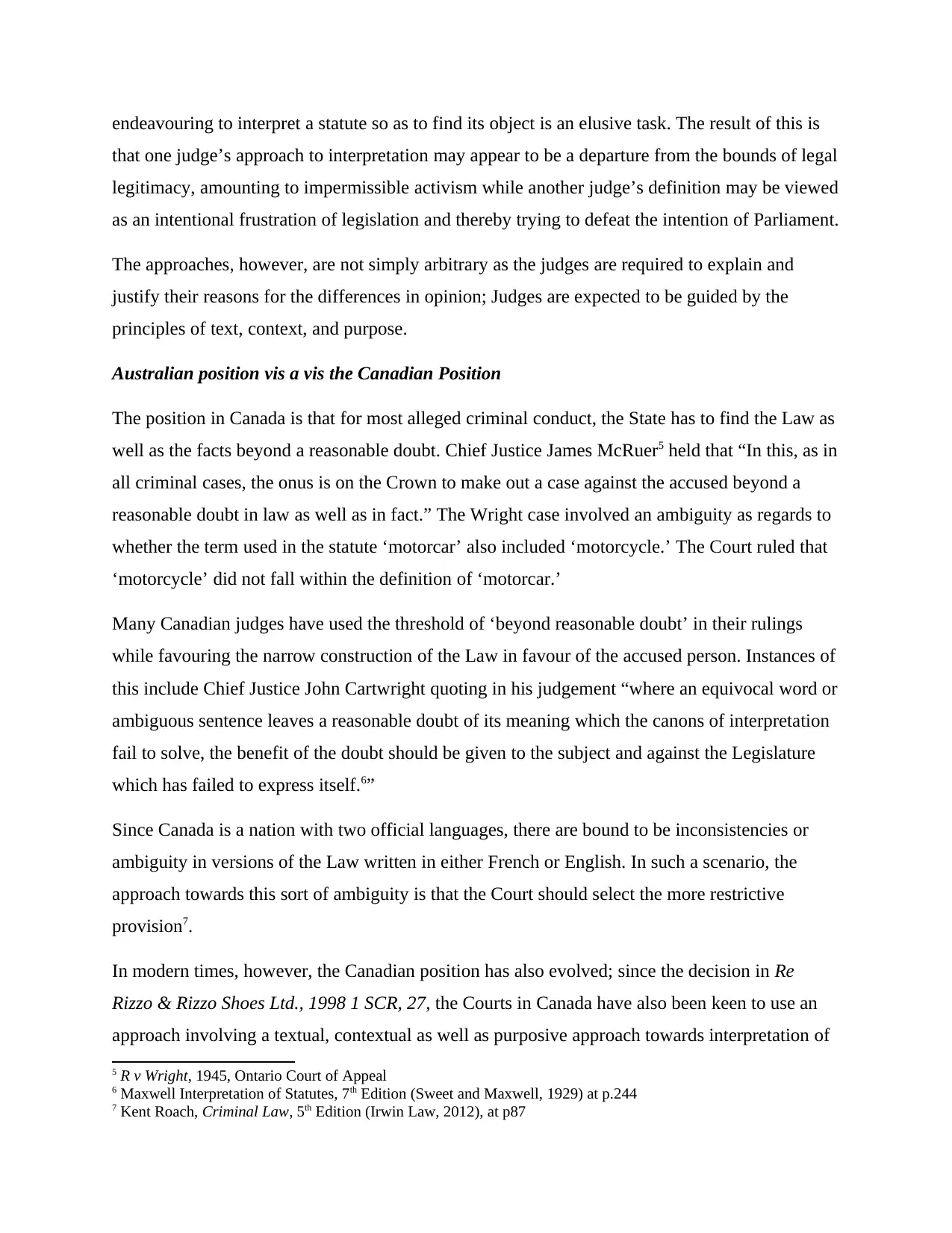
endeavouring to interpret a statute so as to find its object is an elusive task. The result of this is
that one judge’s approach to interpretation may appear to be a departure from the bounds of legal
legitimacy, amounting to impermissible activism while another judge’s definition may be viewed
as an intentional frustration of legislation and thereby trying to defeat the intention of Parliament.
The approaches, however, are not simply arbitrary as the judges are required to explain and
justify their reasons for the differences in opinion; Judges are expected to be guided by the
principles of text, context, and purpose.
Australian position vis a vis the Canadian Position
The position in Canada is that for most alleged criminal conduct, the State has to find the Law as
well as the facts beyond a reasonable doubt. Chief Justice James McRuer5 held that “In this, as in
all criminal cases, the onus is on the Crown to make out a case against the accused beyond a
reasonable doubt in law as well as in fact.” The Wright case involved an ambiguity as regards to
whether the term used in the statute ‘motorcar’ also included ‘motorcycle.’ The Court ruled that
‘motorcycle’ did not fall within the definition of ‘motorcar.’
Many Canadian judges have used the threshold of ‘beyond reasonable doubt’ in their rulings
while favouring the narrow construction of the Law in favour of the accused person. Instances of
this include Chief Justice John Cartwright quoting in his judgement “where an equivocal word or
ambiguous sentence leaves a reasonable doubt of its meaning which the canons of interpretation
fail to solve, the benefit of the doubt should be given to the subject and against the Legislature
which has failed to express itself.6”
Since Canada is a nation with two official languages, there are bound to be inconsistencies or
ambiguity in versions of the Law written in either French or English. In such a scenario, the
approach towards this sort of ambiguity is that the Court should select the more restrictive
provision7.
In modern times, however, the Canadian position has also evolved; since the decision in Re
Rizzo & Rizzo Shoes Ltd., 1998 1 SCR, 27, the Courts in Canada have also been keen to use an
approach involving a textual, contextual as well as purposive approach towards interpretation of
5 R v Wright, 1945, Ontario Court of Appeal
6 Maxwell Interpretation of Statutes, 7th Edition (Sweet and Maxwell, 1929) at p.244
7 Kent Roach, Criminal Law, 5th Edition (Irwin Law, 2012), at p87
that one judge’s approach to interpretation may appear to be a departure from the bounds of legal
legitimacy, amounting to impermissible activism while another judge’s definition may be viewed
as an intentional frustration of legislation and thereby trying to defeat the intention of Parliament.
The approaches, however, are not simply arbitrary as the judges are required to explain and
justify their reasons for the differences in opinion; Judges are expected to be guided by the
principles of text, context, and purpose.
Australian position vis a vis the Canadian Position
The position in Canada is that for most alleged criminal conduct, the State has to find the Law as
well as the facts beyond a reasonable doubt. Chief Justice James McRuer5 held that “In this, as in
all criminal cases, the onus is on the Crown to make out a case against the accused beyond a
reasonable doubt in law as well as in fact.” The Wright case involved an ambiguity as regards to
whether the term used in the statute ‘motorcar’ also included ‘motorcycle.’ The Court ruled that
‘motorcycle’ did not fall within the definition of ‘motorcar.’
Many Canadian judges have used the threshold of ‘beyond reasonable doubt’ in their rulings
while favouring the narrow construction of the Law in favour of the accused person. Instances of
this include Chief Justice John Cartwright quoting in his judgement “where an equivocal word or
ambiguous sentence leaves a reasonable doubt of its meaning which the canons of interpretation
fail to solve, the benefit of the doubt should be given to the subject and against the Legislature
which has failed to express itself.6”
Since Canada is a nation with two official languages, there are bound to be inconsistencies or
ambiguity in versions of the Law written in either French or English. In such a scenario, the
approach towards this sort of ambiguity is that the Court should select the more restrictive
provision7.
In modern times, however, the Canadian position has also evolved; since the decision in Re
Rizzo & Rizzo Shoes Ltd., 1998 1 SCR, 27, the Courts in Canada have also been keen to use an
approach involving a textual, contextual as well as purposive approach towards interpretation of
5 R v Wright, 1945, Ontario Court of Appeal
6 Maxwell Interpretation of Statutes, 7th Edition (Sweet and Maxwell, 1929) at p.244
7 Kent Roach, Criminal Law, 5th Edition (Irwin Law, 2012), at p87
Paraphrase This Document
Need a fresh take? Get an instant paraphrase of this document with our AI Paraphraser
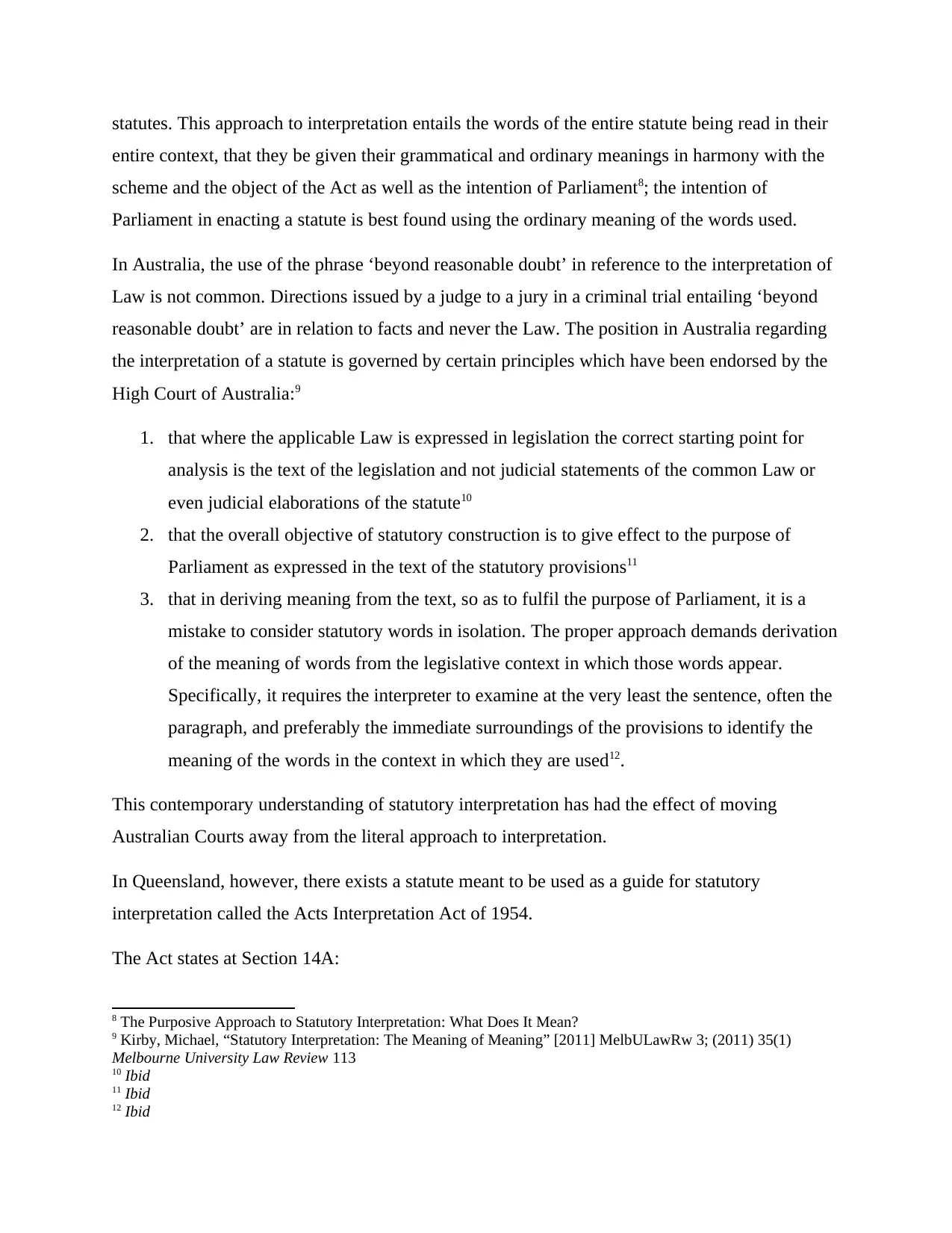
statutes. This approach to interpretation entails the words of the entire statute being read in their
entire context, that they be given their grammatical and ordinary meanings in harmony with the
scheme and the object of the Act as well as the intention of Parliament8; the intention of
Parliament in enacting a statute is best found using the ordinary meaning of the words used.
In Australia, the use of the phrase ‘beyond reasonable doubt’ in reference to the interpretation of
Law is not common. Directions issued by a judge to a jury in a criminal trial entailing ‘beyond
reasonable doubt’ are in relation to facts and never the Law. The position in Australia regarding
the interpretation of a statute is governed by certain principles which have been endorsed by the
High Court of Australia:9
1. that where the applicable Law is expressed in legislation the correct starting point for
analysis is the text of the legislation and not judicial statements of the common Law or
even judicial elaborations of the statute10
2. that the overall objective of statutory construction is to give effect to the purpose of
Parliament as expressed in the text of the statutory provisions11
3. that in deriving meaning from the text, so as to fulfil the purpose of Parliament, it is a
mistake to consider statutory words in isolation. The proper approach demands derivation
of the meaning of words from the legislative context in which those words appear.
Specifically, it requires the interpreter to examine at the very least the sentence, often the
paragraph, and preferably the immediate surroundings of the provisions to identify the
meaning of the words in the context in which they are used12.
This contemporary understanding of statutory interpretation has had the effect of moving
Australian Courts away from the literal approach to interpretation.
In Queensland, however, there exists a statute meant to be used as a guide for statutory
interpretation called the Acts Interpretation Act of 1954.
The Act states at Section 14A:
8 The Purposive Approach to Statutory Interpretation: What Does It Mean?
9 Kirby, Michael, “Statutory Interpretation: The Meaning of Meaning” [2011] MelbULawRw 3; (2011) 35(1)
Melbourne University Law Review 113
10 Ibid
11 Ibid
12 Ibid
entire context, that they be given their grammatical and ordinary meanings in harmony with the
scheme and the object of the Act as well as the intention of Parliament8; the intention of
Parliament in enacting a statute is best found using the ordinary meaning of the words used.
In Australia, the use of the phrase ‘beyond reasonable doubt’ in reference to the interpretation of
Law is not common. Directions issued by a judge to a jury in a criminal trial entailing ‘beyond
reasonable doubt’ are in relation to facts and never the Law. The position in Australia regarding
the interpretation of a statute is governed by certain principles which have been endorsed by the
High Court of Australia:9
1. that where the applicable Law is expressed in legislation the correct starting point for
analysis is the text of the legislation and not judicial statements of the common Law or
even judicial elaborations of the statute10
2. that the overall objective of statutory construction is to give effect to the purpose of
Parliament as expressed in the text of the statutory provisions11
3. that in deriving meaning from the text, so as to fulfil the purpose of Parliament, it is a
mistake to consider statutory words in isolation. The proper approach demands derivation
of the meaning of words from the legislative context in which those words appear.
Specifically, it requires the interpreter to examine at the very least the sentence, often the
paragraph, and preferably the immediate surroundings of the provisions to identify the
meaning of the words in the context in which they are used12.
This contemporary understanding of statutory interpretation has had the effect of moving
Australian Courts away from the literal approach to interpretation.
In Queensland, however, there exists a statute meant to be used as a guide for statutory
interpretation called the Acts Interpretation Act of 1954.
The Act states at Section 14A:
8 The Purposive Approach to Statutory Interpretation: What Does It Mean?
9 Kirby, Michael, “Statutory Interpretation: The Meaning of Meaning” [2011] MelbULawRw 3; (2011) 35(1)
Melbourne University Law Review 113
10 Ibid
11 Ibid
12 Ibid
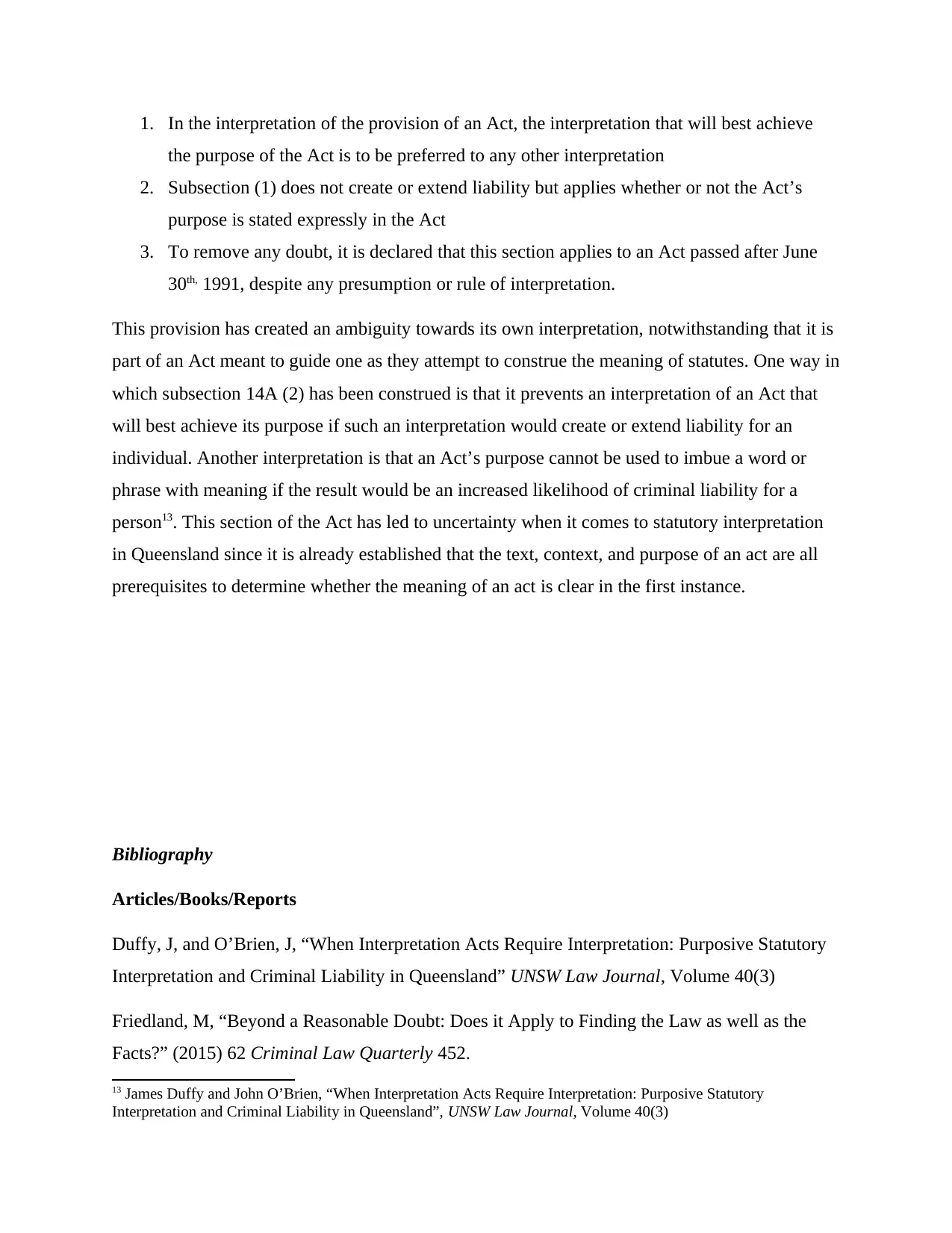
1. In the interpretation of the provision of an Act, the interpretation that will best achieve
the purpose of the Act is to be preferred to any other interpretation
2. Subsection (1) does not create or extend liability but applies whether or not the Act’s
purpose is stated expressly in the Act
3. To remove any doubt, it is declared that this section applies to an Act passed after June
30th, 1991, despite any presumption or rule of interpretation.
This provision has created an ambiguity towards its own interpretation, notwithstanding that it is
part of an Act meant to guide one as they attempt to construe the meaning of statutes. One way in
which subsection 14A (2) has been construed is that it prevents an interpretation of an Act that
will best achieve its purpose if such an interpretation would create or extend liability for an
individual. Another interpretation is that an Act’s purpose cannot be used to imbue a word or
phrase with meaning if the result would be an increased likelihood of criminal liability for a
person13. This section of the Act has led to uncertainty when it comes to statutory interpretation
in Queensland since it is already established that the text, context, and purpose of an act are all
prerequisites to determine whether the meaning of an act is clear in the first instance.
Bibliography
Articles/Books/Reports
Duffy, J, and O’Brien, J, “When Interpretation Acts Require Interpretation: Purposive Statutory
Interpretation and Criminal Liability in Queensland” UNSW Law Journal, Volume 40(3)
Friedland, M, “Beyond a Reasonable Doubt: Does it Apply to Finding the Law as well as the
Facts?” (2015) 62 Criminal Law Quarterly 452.
13 James Duffy and John O’Brien, “When Interpretation Acts Require Interpretation: Purposive Statutory
Interpretation and Criminal Liability in Queensland”, UNSW Law Journal, Volume 40(3)
the purpose of the Act is to be preferred to any other interpretation
2. Subsection (1) does not create or extend liability but applies whether or not the Act’s
purpose is stated expressly in the Act
3. To remove any doubt, it is declared that this section applies to an Act passed after June
30th, 1991, despite any presumption or rule of interpretation.
This provision has created an ambiguity towards its own interpretation, notwithstanding that it is
part of an Act meant to guide one as they attempt to construe the meaning of statutes. One way in
which subsection 14A (2) has been construed is that it prevents an interpretation of an Act that
will best achieve its purpose if such an interpretation would create or extend liability for an
individual. Another interpretation is that an Act’s purpose cannot be used to imbue a word or
phrase with meaning if the result would be an increased likelihood of criminal liability for a
person13. This section of the Act has led to uncertainty when it comes to statutory interpretation
in Queensland since it is already established that the text, context, and purpose of an act are all
prerequisites to determine whether the meaning of an act is clear in the first instance.
Bibliography
Articles/Books/Reports
Duffy, J, and O’Brien, J, “When Interpretation Acts Require Interpretation: Purposive Statutory
Interpretation and Criminal Liability in Queensland” UNSW Law Journal, Volume 40(3)
Friedland, M, “Beyond a Reasonable Doubt: Does it Apply to Finding the Law as well as the
Facts?” (2015) 62 Criminal Law Quarterly 452.
13 James Duffy and John O’Brien, “When Interpretation Acts Require Interpretation: Purposive Statutory
Interpretation and Criminal Liability in Queensland”, UNSW Law Journal, Volume 40(3)
⊘ This is a preview!⊘
Do you want full access?
Subscribe today to unlock all pages.

Trusted by 1+ million students worldwide
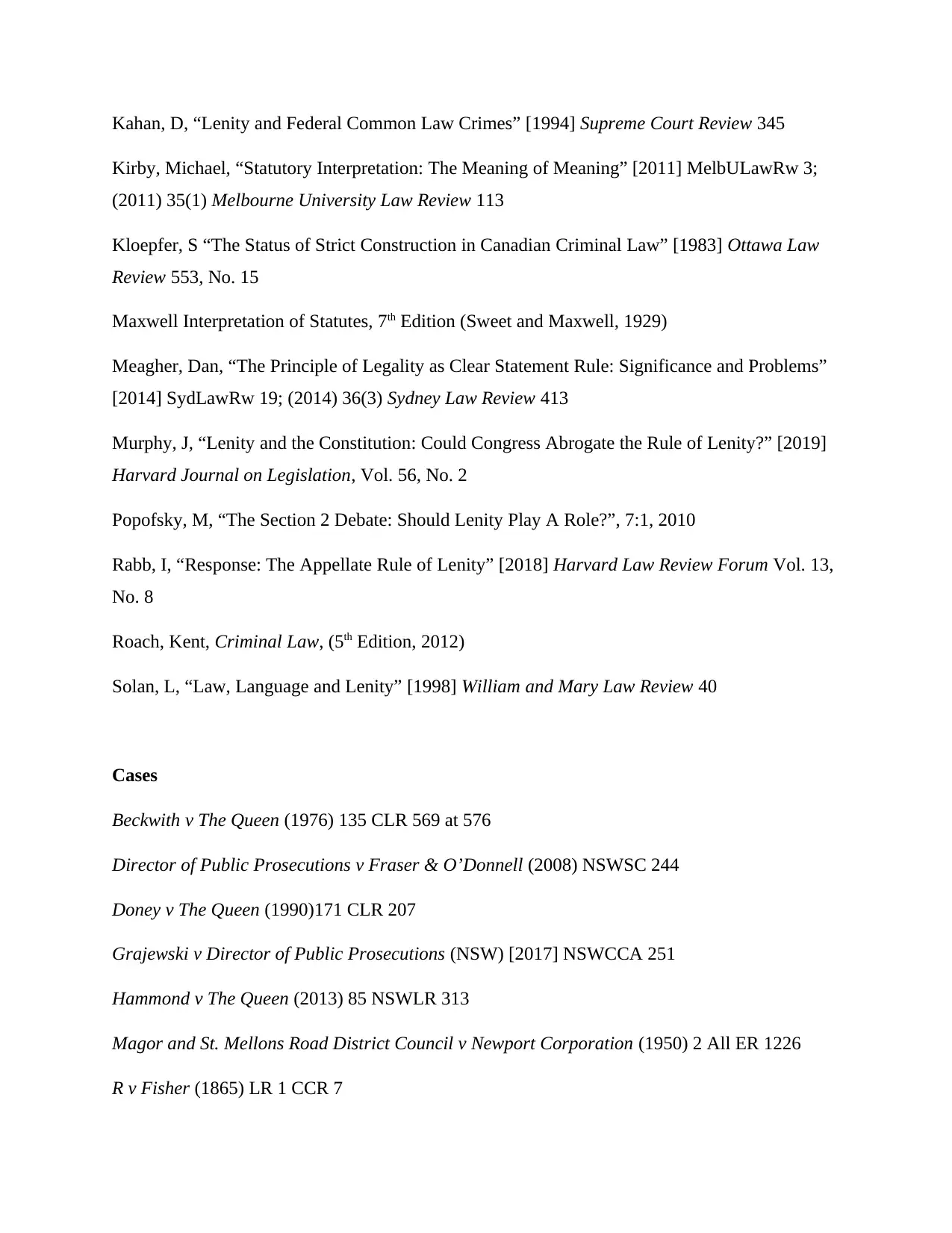
Kahan, D, “Lenity and Federal Common Law Crimes” [1994] Supreme Court Review 345
Kirby, Michael, “Statutory Interpretation: The Meaning of Meaning” [2011] MelbULawRw 3;
(2011) 35(1) Melbourne University Law Review 113
Kloepfer, S “The Status of Strict Construction in Canadian Criminal Law” [1983] Ottawa Law
Review 553, No. 15
Maxwell Interpretation of Statutes, 7th Edition (Sweet and Maxwell, 1929)
Meagher, Dan, “The Principle of Legality as Clear Statement Rule: Significance and Problems”
[2014] SydLawRw 19; (2014) 36(3) Sydney Law Review 413
Murphy, J, “Lenity and the Constitution: Could Congress Abrogate the Rule of Lenity?” [2019]
Harvard Journal on Legislation, Vol. 56, No. 2
Popofsky, M, “The Section 2 Debate: Should Lenity Play A Role?”, 7:1, 2010
Rabb, I, “Response: The Appellate Rule of Lenity” [2018] Harvard Law Review Forum Vol. 13,
No. 8
Roach, Kent, Criminal Law, (5th Edition, 2012)
Solan, L, “Law, Language and Lenity” [1998] William and Mary Law Review 40
Cases
Beckwith v The Queen (1976) 135 CLR 569 at 576
Director of Public Prosecutions v Fraser & O’Donnell (2008) NSWSC 244
Doney v The Queen (1990)171 CLR 207
Grajewski v Director of Public Prosecutions (NSW) [2017] NSWCCA 251
Hammond v The Queen (2013) 85 NSWLR 313
Magor and St. Mellons Road District Council v Newport Corporation (1950) 2 All ER 1226
R v Fisher (1865) LR 1 CCR 7
Kirby, Michael, “Statutory Interpretation: The Meaning of Meaning” [2011] MelbULawRw 3;
(2011) 35(1) Melbourne University Law Review 113
Kloepfer, S “The Status of Strict Construction in Canadian Criminal Law” [1983] Ottawa Law
Review 553, No. 15
Maxwell Interpretation of Statutes, 7th Edition (Sweet and Maxwell, 1929)
Meagher, Dan, “The Principle of Legality as Clear Statement Rule: Significance and Problems”
[2014] SydLawRw 19; (2014) 36(3) Sydney Law Review 413
Murphy, J, “Lenity and the Constitution: Could Congress Abrogate the Rule of Lenity?” [2019]
Harvard Journal on Legislation, Vol. 56, No. 2
Popofsky, M, “The Section 2 Debate: Should Lenity Play A Role?”, 7:1, 2010
Rabb, I, “Response: The Appellate Rule of Lenity” [2018] Harvard Law Review Forum Vol. 13,
No. 8
Roach, Kent, Criminal Law, (5th Edition, 2012)
Solan, L, “Law, Language and Lenity” [1998] William and Mary Law Review 40
Cases
Beckwith v The Queen (1976) 135 CLR 569 at 576
Director of Public Prosecutions v Fraser & O’Donnell (2008) NSWSC 244
Doney v The Queen (1990)171 CLR 207
Grajewski v Director of Public Prosecutions (NSW) [2017] NSWCCA 251
Hammond v The Queen (2013) 85 NSWLR 313
Magor and St. Mellons Road District Council v Newport Corporation (1950) 2 All ER 1226
R v Fisher (1865) LR 1 CCR 7
Paraphrase This Document
Need a fresh take? Get an instant paraphrase of this document with our AI Paraphraser
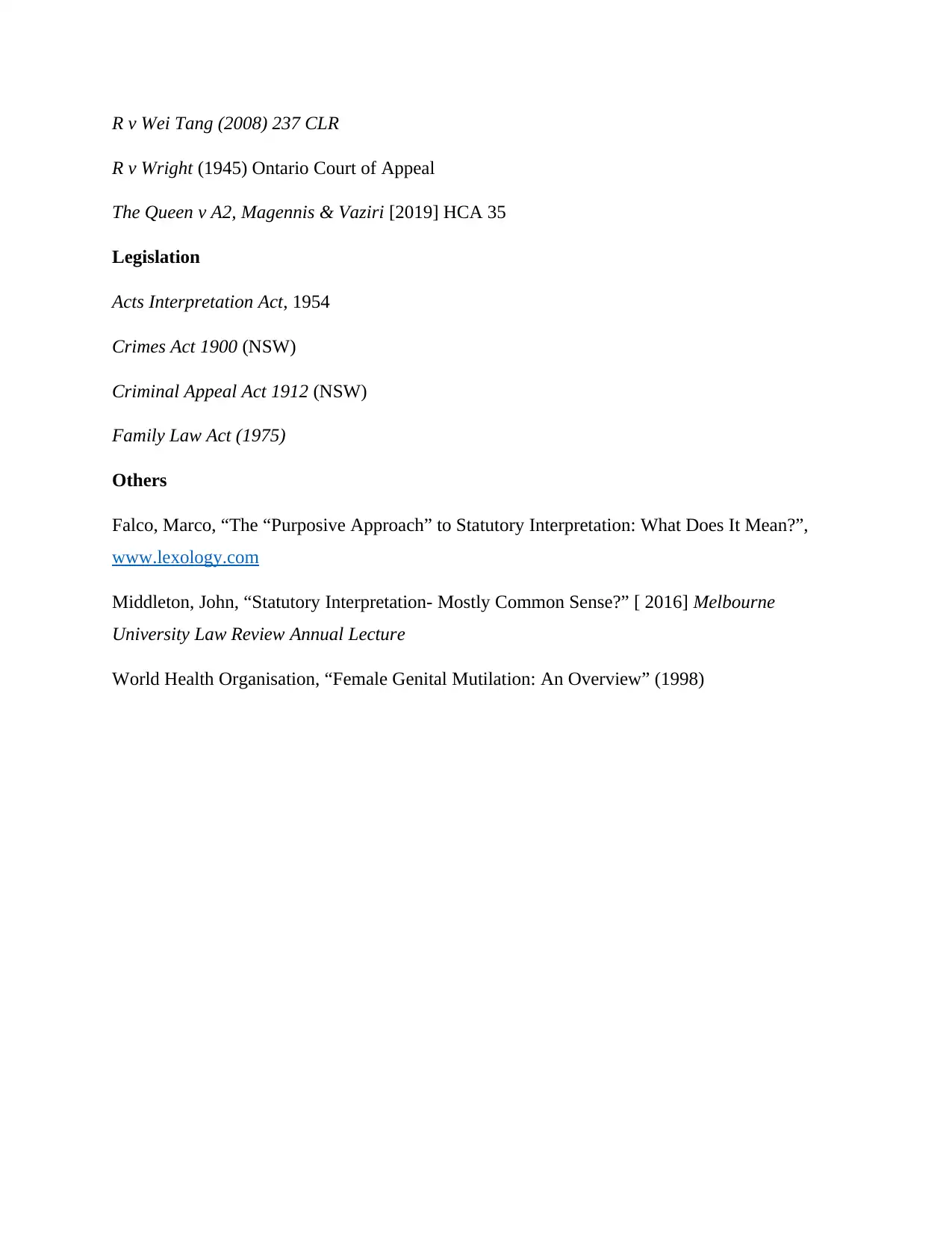
R v Wei Tang (2008) 237 CLR
R v Wright (1945) Ontario Court of Appeal
The Queen v A2, Magennis & Vaziri [2019] HCA 35
Legislation
Acts Interpretation Act, 1954
Crimes Act 1900 (NSW)
Criminal Appeal Act 1912 (NSW)
Family Law Act (1975)
Others
Falco, Marco, “The “Purposive Approach” to Statutory Interpretation: What Does It Mean?”,
www.lexology.com
Middleton, John, “Statutory Interpretation- Mostly Common Sense?” [ 2016] Melbourne
University Law Review Annual Lecture
World Health Organisation, “Female Genital Mutilation: An Overview” (1998)
R v Wright (1945) Ontario Court of Appeal
The Queen v A2, Magennis & Vaziri [2019] HCA 35
Legislation
Acts Interpretation Act, 1954
Crimes Act 1900 (NSW)
Criminal Appeal Act 1912 (NSW)
Family Law Act (1975)
Others
Falco, Marco, “The “Purposive Approach” to Statutory Interpretation: What Does It Mean?”,
www.lexology.com
Middleton, John, “Statutory Interpretation- Mostly Common Sense?” [ 2016] Melbourne
University Law Review Annual Lecture
World Health Organisation, “Female Genital Mutilation: An Overview” (1998)
1 out of 11
Your All-in-One AI-Powered Toolkit for Academic Success.
+13062052269
info@desklib.com
Available 24*7 on WhatsApp / Email
![[object Object]](/_next/static/media/star-bottom.7253800d.svg)
Unlock your academic potential
Copyright © 2020–2025 A2Z Services. All Rights Reserved. Developed and managed by ZUCOL.
